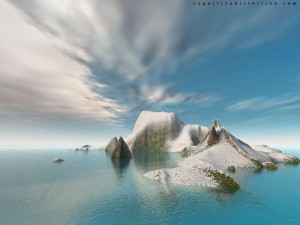
Arts Report co-host Sara Lapsley reviews films from VIFF 2013. Arctic Defenders screens again October 4th at SFU Woodwards, while Aatsinki: Arctic Cowboys screens again October 11th at VanCity Theatre.
Two documentaries at the 2013 VIFF take us North of the Arctic Circle. One is set in Canada, the other in Finnish Lapland.
As a young man, Arctic Defenders director John Waters visited what is now the Territory of Nunavut. He never forgot the children he photographed, and returned as a man in his late fifties to find them again.
This is a portrait of the Inuit people—resourceful, resilient, intelligent, humorous, and humble. But it also tells the tale of a Canadian history that few of us know. The British colonists recognized the importance of staking a claim in the Arctic, in order to protect it from interests abroad.
To this end, the RCMP relocated impoverished Inuit families from Northern Quebec above the Arctic line, where their habitation continues to protect our sovereignty. The Inuit were heartbroken by their relocation. In order prevent them from returning to their ancestral lands, the Government of Canada slaughtered 22,000 sled dogs, their primary source of transportation. While efforts at assimilation were still made, the domination of the Inuit was never fully achieved. The few white men that lived in the North were reliant on the Inuit for navigation and sustenance. No Southerner could last even a few hours in the harsh environment without their help.
A cohort of savvy young Inuit emerged in the 1960’s: bright, articulate and passionate about self-governance. Priding themselves on the qualities of persistence, patience and gentle persuasion, they were able to create the territory of Nunavut. Arctic Defenders bears witness to their pride in this achievement. The film also takes us to the desolate, otherworldly landscapes of the Tundra, inside the Nunavut legislature, and into the communities of the Inuit, who share sad stories of suicide, poverty, melting ice, and betrayal by the government. Arctic Defenders should be required viewing for every Canadian.
I went out with high hopes for Aatsinki: The Story of Arctic Cowboys, set in Finnish Lapland. Billed as an ethnography, this is a documentary that lacks a narrative. Rather, the camera is a “fly on the wall” as we follow a year in the life of Lappish reindeer herders. This approach may be faulty in itself, or perhaps the filmmaker lacks experience in the genre. Whatever the reason, I failed to be engaged, despite my fascination for the culture.
The characters exist in a vacuum; it is difficult to sense the relationship between them and the community they inhabit. For reindeer herders, they certainly live well—one suspects there is a thriving town just outside the camera lens, suggesting that the isolation and wilderness may be an illusion. Perhaps it was naïve to expect a romantic portrait of the Laplanders, but the viewer is unprepared for the initial scene in which wild reindeer are herded into a pen with a helicopter, and then slaughtered in a most gruesome manner. We get no sense of any depth or urgency– even the changing of the Northern seasons is somehow bland. No sense of the fierceness of nature, or of the Lappish history or spirituality. But it is the simple things that enchant in this film—knives engraved with runic designs, hand-crafted elvish belts, fur hats, roasting fish over an open fire, soft snow drifting on pine trees in the winter sun.
Arctic Cowboys is billed as “innately soulful”, which is somewhat misleading. Though not without its merits, we develop little feeling for the characters, and the tension between the traditional and the modern is not fully explored.
Listen to more VIFF reviews on this week’s Arts Report, Wed Oct 2 5pm.
